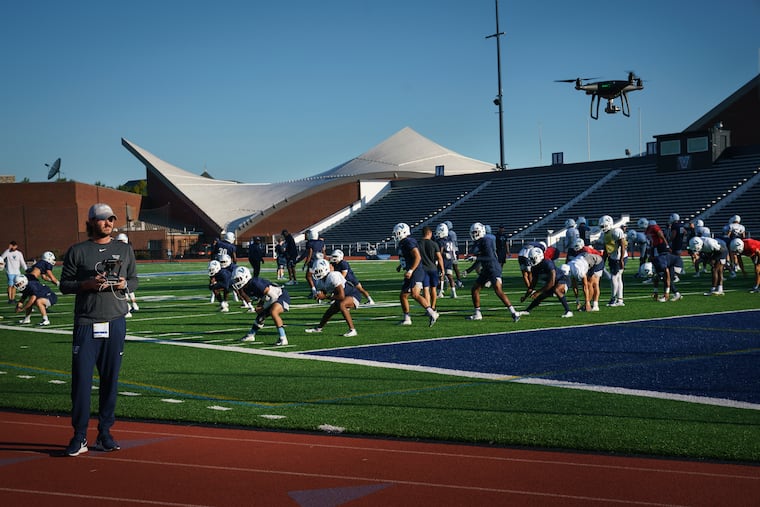Villanova’s secret football weapon: drones | Mike Jensen
“I do think it’s a bit of a competitive advantage,’’ Villanova video coordinator TJ Landis says of the drones. “It’s such a better shot.”

Stop by a Villanova football practice, or even glance over at the football stadium from Lancaster Avenue during a practice. There’s something missing.
For years, if you saw a college team practicing, you might have seen one of those lifts past an end zone, and a person or two up there filming the practice. Just part of the landscape. The practice isn’t over until those lifts come down.
Not at Villanova, not anymore. No lift, no camera.
What’s different? Look a little higher in the sky.
Drones, baby.
There’s little a football coach likes better than a clear look at his own football players doing their thing. Enter the drone, hovering 18 meters above the field according to its data display. As Villanova shifted hash marks to start a play, Villanova video coordinator TJ Landis shifted the drone from his console on the sideline.
“I do think it’s a bit of a competitive advantage,’’ Landis said as the drone hovered above. “It’s such a better shot.”
Villanova purchased one last season and liked it so much, the school got a second for this season, so it can swap out the units during a practice, sending the latest film in for assistants to index and prepare for coaches and players to watch ASAP. They also used the dueling drones during summer practice when it was more worthwhile to be shooting both ends of the field.
“For the offensive line, it’s awesome — you see everything,’’ Villanova coach Mark Ferrante said. “When you’re behind, you see steps; sometimes you don’t see the hand placement.”
Quarterback Daniel Smith, who has thrown 13 TD passes and run for four through Villanova’s 4-0 start, offers a thumbs up. Can he tell the difference in angles?
“Instead of seeing the back view, and not really seeing the defense as much, you can see the alignment of all the secondary and the linebackers,’’ Smith said after practice preparing for Saturday’s game against Maine. “You can really see every angle of what you need to see studying film.”
And see it sharper, Smith mentioned.
“The green on the field is super bright compared to other cameras,’’ the QB said.
The Villanova coaches know of a couple of other FCS schools that use a drone this way, and at least one D-III school that looked at Nova’s use and bought one.
“One of our volunteer assistants two years ago was at Ursinus College and they used it for filming a couple of periods during practice,’’ Landis said. “I was like, ‘No way!’ “
They looked into it, and compared expenses.
“To get one of those lifts is pretty expensive, to rent it for a year,’’ Landis said, estimating the drone cost less than $1,500. “”We want to get a brand-new camera, it’s going to be more than that.”
“It pays for itself,’’ Ferrante said.
Originally, Landis said, he figured he would just use it for some cool video looks, “for recruiting, to put on Twitter. Then we filmed a couple of [practice] periods with it and the coaches were like, you’re filming everything with it.”
Landis still has a student film practice from the top of the press box to get a sideline view. He splices the two looks together right after practice, then another assistant, Lenny Smith, adds the play calls, so everything is quickly indexed. Sometimes, an assistant coach will ask for a specific angle to be filmed.
If it isn’t unique to Villanova, it isn’t a regular thing yet, either, even at big-time football schools.
“We’ll get scouts through here pretty often, NFL scouts,’’ Landis said. “One of the guys who was here the other day said he had never seen that at all.”
What if the drone’s battery goes dead? Look out below?
“When I take it up, it has a GPS location, from where it takes off,’’ Landis said, adding that this has never happened. “It calls it its at-home point. So if it ever runs out of battery, it’ll just fly back to that spot.”
Landis said the drone is good in rain or snow, counting three times he didn’t send it up because of heavy rain or snow.
"It handles wind very well with the camera stabilizer it has,'' Landis added. “You would never know the difference watching film between a 5-mph wind day and a 15-mph wind day.”
When winds were at 25 mph one time, he said, he kept it down.
The entire sport is aware of practice winds and how in 2010 a Notre Dame undergraduate died after the tower on which he was filming football practice fell over in high winds. "I am very familiar with the Notre Dame story,'' Landis said.
Looking at Wednesday morning’s clear sky, you saw airplanes higher up, a helicopter a little lower at one point, nothing else closer to compete with the drone. It’s easy, however, to imagine possibilities. Picture paranoid coaches wondering if that’s the competition sending a drone over to film. Is that a Delaware drone?
OK, maybe not, but you can’t be too careful. You don’t think Auburn would send a drone up to film Alabama?
Landis said: “A couple of our coaches have said, ‘If I ever have to leave this place and go somewhere else, I’m telling the video guy, we’re getting a drone.’ ‘’
“You get spoiled by the drone shot,’’ Ferrante said. “Sometimes you’re watching game film, it’s not as good.”